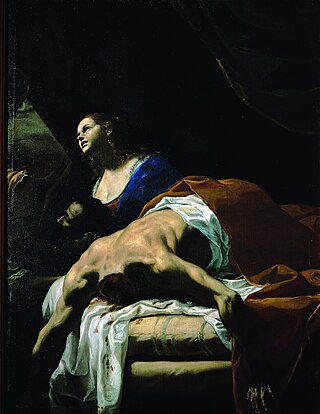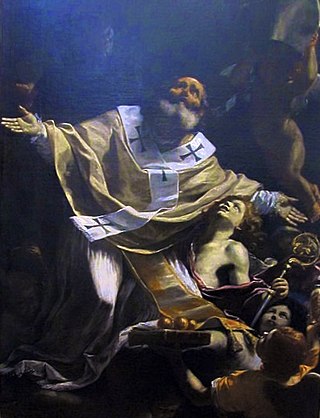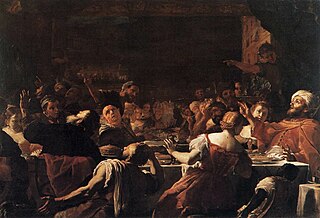
The Return of the Prodigal Son is a 1656 oil on canvas painting by Mattia Preti, now in the Museo nazionale di Capodimonte in Naples. [1]

The Return of the Prodigal Son is a 1656 oil on canvas painting by Mattia Preti, now in the Museo nazionale di Capodimonte in Naples. [1]
It originated in the collection of Diomede V Carafa, fifth Duke of Maddaloni, which also contained four other of Preti's works - Christ and the Canaanite Woman (now in Stoccarda), Christ Throwing Down Satan (also now in the Capodimonte), Christ Tempted by Satan (now in the Chiesa dell'Annunciata in Maddaloni) and Christ and the Centurion (now in Palermo). [1] Historical records show Carafa paying Preti a sum equal to 220 ducats for five works. [1] Christ Throwing Down Satan, Christ and the Centurion and Prodigal all entered the collection of Francesco Antonio Roberti, a civil judge in Naples, before being bought by the Bourbons for a total of 2,000 ducats. [1]

Polidoro Caldara, usually known as Polidoro da Caravaggio was an Italian painter of the Mannerist period, "arguably the most gifted and certainly the least conventional of Raphael's pupils", who was best known for his now-vanished paintings on the facades of Roman houses. He was unrelated to the later painter Michelangelo Merisi da Caravaggio, usually known just as Caravaggio, but both came from the town of Caravaggio.

Museo di Capodimonte is an art museum located in the Palace of Capodimonte, a grand Bourbon palazzo in Naples, Italy. The museum is the prime repository of Neapolitan painting and decorative art, with several important works from other Italian schools of painting, and some important ancient Roman sculptures. It is one of the largest museums in Italy. The museum was inaugurated in 1957.

Giovanni Battista Caracciolo (1578–1635) was an Italian artist and important Neapolitan follower of Caravaggio. He was a member of the murderous Cabal of Naples, with Belisario Corenzio and Giambattista Caracciolo, who were rumoured to have poisoned and disappeared their competition for painting contracts.

Mattia Preti was an Italian Baroque artist who worked in Italy and Malta. He was appointed a Member of the Order of Saint John.

Francesco de Mura was an Italian painter of the late-Baroque period, active mainly in Naples and Turin. His late work reflects the style of neoclassicism.

Salvatore Fergola was an Italian painter, mainly of landscapes or vedute in and around his native Naples. He is considered an exponent of the School of Posillipo.

Santa Maria ad Ogni Bene dei Sette Dolori, also known as Santa Maria de Sette Dolori, is a Roman Catholic church in Naples, Italy. It stands on a hill, providing an excellent view of Spaccanapoli, a Decumanus of Naples which ends across via Francesco Girardi. From the door of the church, one has a direct view across Naples through the straight decumanus. The church also faces the former convent of Santissima Trinità delle Monache.

Casa Cosmana Navarra is a 17th-century aristocratic townhouse in Rabat, Malta. The building belonged to Cosmana Navarra (1600-1687), for whom it is named until date, who was the main benefactress of the rebuilding of the Rabat parish church of St. Paul. The house is found in front of the parish church opposite the Wignacourt Museum. Most of the building was converted into a restaurant, namely the Ristorante Cosmana Navarra.

Saint Sebastian is an oil on canvas painting by Italian artist Mattia Preti, created c. 1657. It represents Saint Sebastian, and is held in the National Museum of Capodimonte, in Naples.

Princess Giovanna van den Eynde was a member of the Van den Eynde family, Marchioness of Castelnuovo by birth, and the Princess consort of Galatro and Sonnino. She was the daughter of Ferdinand van den Eynde, 1st Marquess of Castelnuovo, son of the magnate Jan van den Eynde, and Olimpia Piccolomini, of the House of Piccolomini. Through her marriage to Giuliano Colonna, Giovanna became a member of the House of Colonna, and the first Princess of Sonnino. Through his marriage to her, Giovanna's husband acquired the title of Marquess of Castelnuovo.

Judith and Holofernes is an oil on canvas painting by Italian artist Mattia Preti, datable to around 1653–1656. It is held at the Museo di Capodimonte, in Naples.

Penitent Magdalene is a c. 1550 oil on canvas painting by Titian, now in the Museo di Capodimonte in Naples.

Madonna of Constantinople is a c. 1656 oil on canvas painting by Mattia Preti. It was the first of many works commissioned as ex-votos for freeing the city from the plague of 1656 – they all showed the Madonna with a selection of the city's patron saints, in this case Joseph, Januarius, Roch, Nicasius and Rosalia (centre). It now hangs in the Museo nazionale di Capodimonte in Naples.

Portrait of Pope Paul III with Camauro is a 1545 – 1546 oil on canvas painting by Titian, now in the Museo nazionale di Capodimonte in Naples.

The Earthly Trinity with Saints and God the Father are a pair of c.1626-c.1635 oil on canvas paintings by Jusepe de Ribera, both now in the Museo nazionale di Capodimonte in Naples. Along with the Holy Family, the main work shows Bruno of Cologne, Benedict of Nursia, Bernardino of Siena and Bonaventure.

Saint John the Baptist is a c.1653-1656 oil on canvas painting by Mattia Preti, now in the Museo nazionale di Capodimonte in Naples.

Saint Nicholas is a c. 1653 painting by Mattia Preti, the first work he produced after moving to Naples and showing the three gold balls which are a traditional attribute of the saint. It is now in the Museo nazionale di Capodimonte in the same city. He also produced a larger version of the work in 1657 which is now in the Pinacoteca civica in Fano, with an early copy after the Capodimonte version now in the church of Santa Teresa degli Scalzi in Naples.

The Banquet of Absalom is an oil on canvas painting by Mattia Preti, created in c. 1660–1665, now in the Museo nazionale di Capodimonte in Naples. It illustrates a passage from chapters 13 and 14 of 2 Samuel in the Old Testament, in which King David's son Absalom avenges the rape of Absalom's sister Tamar two years earlier by inviting her rapist Amnon to a feast, getting him drunk and then killing him.

Belshazzar's Feast is a circa 1660-1665 oil on canvas painting by Mattia Preti, now in the Museo nazionale di Capodimonte in Naples. It shows a scene from chapter 5 of the Book of Daniel.

The Return of the Prodigal Son is a c. 1658 oil on canvas painting by Mattia Preti, now in the Royal Palace of Naples.